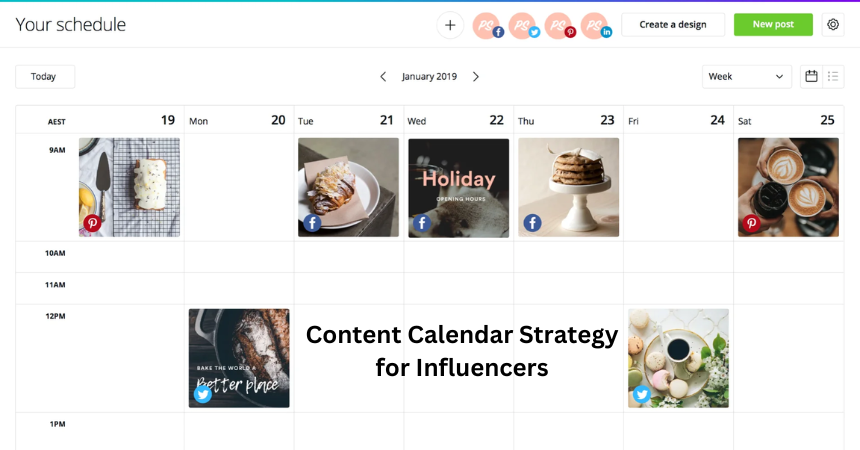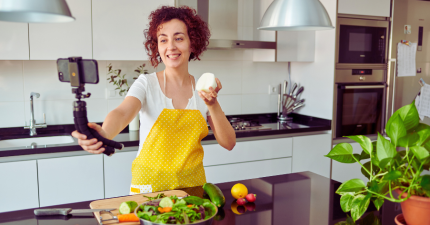
- 09 Nov, 2024
Content Calendar Strategies for Influencers: Plan Ahead and Boost Productivity
As an influencer, maintaining a consistent presence on social media is crucial to growing and engaging your audience. However, balancing sponsored content, personal updates, and creative projects can be overwhelming. That’s where a content calendar comes in. By planning your posts, you’ll boost productivity, stay organized, and build a strong, cohesive brand presence.
In this guide, we’ll walk you through practical content calendar strategies to help you streamline your social media planning, enhance productivity, and keep your audience engaged.
Why Influencers Need a Content Calendar
A content calendar isn’t just a tool for scheduling posts—it’s a roadmap that helps you stay focused on your goals and manage your time effectively. Here are some top benefits of using a content calendar:
- Consistency: Regular posting keeps your audience engaged and improves your chances of staying visible on social media algorithms.
- Efficiency: Planning in advance minimizes last-minute scrambling for content ideas, allowing you to create high-quality posts.
- Goal Tracking: Content calendars help you align your posts with marketing campaigns, seasonal trends, and brand collaborations.
- Stress Reduction: Knowing what to post and when reduces stress, freeing you up to focus on content creation and engagement.
Define Your Content Goals
Before creating a content calendar, take some time to define your goals. These may include increasing engagement, growing followers, promoting brand partnerships, or creating educational content for your audience. Clearly outlining your objectives helps you decide what types of content to include, such as:
- Brand Collaborations: Sponsored posts, product reviews, or giveaways.
- Engagement Posts: Content that encourages comments, shares, or likes (e.g., Q&As, polls).
- Educational Content: Tips, tutorials, or advice related to your niche.
- Seasonal or Trending Content: Holiday-themed posts, current events, or industry trends.
Each goal should tie back to your overall brand strategy, ensuring that every post you schedule adds value to your audience and aligns with your brand identity.
Choose a Content Calendar Tool
Next, pick a tool to organize your content calendar. There are several options available, each with unique features:
- Google Calendar: Ideal for simple scheduling, reminders, and color-coded categories.
- Trello: Offers a board format where you can create lists for each week, track content stages, and add visuals.
- Airtable: A customizable spreadsheet-style tool with multiple views, including calendar and grid, perfect for visualizing content schedules.
- Asana: Great for teams, allowing you to assign tasks, set deadlines, and monitor progress on each post.
Each of these tools enables you to add captions, hashtags, image ideas, and deadlines, making it easier to track and manage all aspects of your content strategy.
Plan Content Themes and Categories
To keep your content diverse and engaging, develop a few main themes or categories that represent your brand. For example, if you’re a fitness influencer, your categories could be:
- Workout Tips
- Healthy Recipes
- Personal Milestones
- Brand Partnerships
- Community Q&A
Rotate these categories throughout the month to ensure your feed doesn’t feel repetitive. Additionally, planning around themes (like #MondayMotivation or #ThrowbackThursday) helps maintain a variety that keeps your audience engaged.
Tip: Create a weekly or monthly theme. For instance, one week could focus on self-care, while another could focus on productivity tips. This keeps your feed fresh and purposeful.
Map Out Your Posting Frequency
Deciding how often to post is key to maintaining consistency. Most influencers find success posting between 3-5 times per week, depending on the platform and audience expectations. Use these frequency guidelines:
- Instagram: 3-5 times per week for posts, with daily Stories to stay in front of your audience.
- TikTok: 3-7 times per week, as TikTok’s algorithm favors frequent updates.
- YouTube: 1-2 times per week, focusing on longer-form, high-quality content.
- Twitter: Daily posts to stay active and relevant, given Twitter’s fast-paced nature.
Adjust your frequency based on what your audience responds to, but remember that quality is always better than quantity.
Align Content with Seasonal Trends and Events
Leverage seasonal events, holidays, and industry-specific trends to keep your content timely and relevant. For instance:
- Seasonal Posts: Share winter skincare routines in December or back-to-school tips in September.
- Holiday Content: Create festive posts around major holidays like Christmas, Halloween, or Valentine’s Day.
- Industry Events: If you’re a tech influencer, align content with major industry events like CES or product launches.
Adding these elements to your calendar ensures you’re prepared to engage with popular trends and create content that resonates with current events.
Schedule Time for Content Creation and Engagement
A successful content calendar not only schedules posting dates but also allocates time for content creation and engagement. Block out specific days to focus on:
- Content Creation: Set aside time for brainstorming, shooting photos, or recording videos. Batch-creating content for multiple posts at once is a great way to stay ahead.
- Editing and Captions: Use tools like Lightroom for photo editing or InShot for video editing, and write engaging captions that align with each post.
- Engagement: Schedule time to respond to comments, engage with followers, and interact with other accounts. Social engagement boosts visibility and builds community.
Track Performance and Adjust Accordingly
To make the most out of your content calendar, regularly review analytics to see what’s working and adjust accordingly. Monitor key metrics like engagement rates, reach, and follower growth using tools like:
- Instagram Insights: Provides data on impressions, reach, and engagement.
- Google Analytics: Useful if you’re driving traffic to a website or blog.
- Sprout Social: A comprehensive tool for tracking performance across multiple platforms.
Regularly evaluating your performance helps you identify trends in what resonates with your audience, so you can optimize future content.
Leave Room for Spontaneity
A content calendar is a structured plan, but it’s also essential to stay flexible. Leave space for spontaneous posts that capture real-time moments, breaking news, or personal updates. Authentic, unplanned content often performs well and helps balance the more curated posts on your feed.
Repurpose Content to Maximize Reach
Creating new content constantly can be time-consuming. Repurposing content allows you to maximize reach without starting from scratch. For example:
- Turn a YouTube video into Instagram Reels by breaking it into shorter clips.
- Create blog posts or Pinterest pins from longer Instagram captions.
- Repost popular Stories as main feed posts to reach a wider audience.
Repurposing allows you to stay consistent while delivering value across multiple platforms.
Final Thoughts
A content calendar is a powerful tool for influencers, helping you stay organized, save time, and deliver high-quality content consistently. By setting goals, defining themes, planning around events, and tracking performance, you’ll streamline your content creation process and improve your overall productivity.
Ready to take your influencer strategy to the next level? Start building your content calendar today and watch your productivity and engagement soar!




